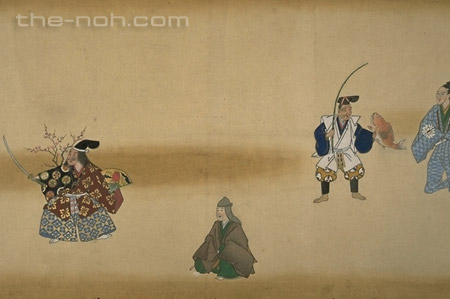
 Ebira (Quiver)
Ebira (Quiver)

![]()
On his way to Kyoto, a monk living in a western province comes to the Ikuta River in Settsu Province and notices a fully blooming plum tree. A man passes by as he is enjoying the blossoms, so the monk inquires about the name of the plum tree. The man responds that it is called “Ebira no Ume” (Plum of the Quiver). The monk further inquires about the origin of the name. The man explains that at the time of the war between the Genji and Heike clans, near the Ikuta River, Kajiwara no Genda Kagesue put a twig of the plum into his quiver and fought very bravely. It is the origin of the name of this plum tree. The man then starts to minutely describe the battle scenes. Evening comes. When the monk asks for lodging for the night, the man reveals that he is the ghost of Kagesue and disappears after advising the monk to stay overnight under the plum tree.
In the middle of the night, while the monk is resting, a young warrior who has a twig of plum blossoms in his quiver appears. The monk inquires who he is, and the warrior responds that he is the ghost of Kagesue and shows himself being compelled to fight in the Realm of Asura. He also shows the battle scene in the Valley of Ichino-tani where he put the plum twig in his quiver and tried to earn honor as the first warrior to cross the enemy lines. While he describes himself fighting against the foe, using his mysterious grand battle techniques, morning comes. In the monk’s dream, the ghost of Kagesue requests the monk to console his soul, bids the monk farewell and then disappears.
![]()
This is one of the pieces called kachi-shura-mono, which includes “Yashima” and “Tamura.” The time is the end of the Heian era, the time when the Genji and Heike clans fought for supremacy. The leading role, Kajiwara no Genda Kagesue, was a warrior fighting on the Genji side and was the eldest son and heir of Kajiwara no Heizo Kagetoki. His father was given an important position by Minamoto no Yoritomo, the founder of a military government. Although he was still young, he fearlessly fought in many battles with his father and won distinction. One of those was the battle at Ichino-tani (Ichinotani Valley.) This piece was inspired by the episode in which Kagesue fought near the Ikuta River in the battle of Ichino-tani with a multi-color flowering branch of plum in his quiver.
The combination of the young warrior with a fully blooming plum branch impresses us with its distinctively brilliant beauty, especially in the bloody and gruesome battlefield. Ancient warriors were not uncouth men who devoted themselves to fighting. Some of them were excellent poets and musicians. They understood what elegance is and were highly sensitive to beauty. Of course, there must have been some rough swashbucklers; however, the military commanders attained high education and possessed their own aesthetic theory. This piece expresses such aesthetics of the warriors in a touching and distinctive manner.
It also describes a fierce, daunting battle scene in a historical war. You will enjoy vigorous dynamism throughout this piece.
STORY PAPER : Ebira (Quiver)
Story Paper presents noh chant stories in modern speech, with story outlines, highlights and more using Adobe PDF format, which can print out and zoom in. Print out the pages and take them with you when you see the actual noh performance.

The copyright of Story Paper is held by the Noh.com. Story Paper is for individual use only. It is prohibited by the copyright law to distribute or publish printed-out Story Paper pages without prior consent. For more information, check the credit and disclaimer pages.



 [Ebira (Quiver) : Story Paper PDF : 652KB
[Ebira (Quiver) : Story Paper PDF : 652KB